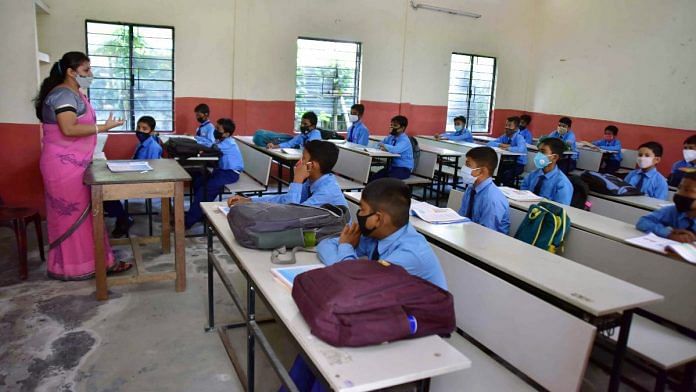
New Delhi: Schools in Andhra Pradesh and Assam reopened Monday after seven months amid the Covid-19 pandemic, registering a mixed response on day one.
Students of Classes 9 to 12 were allowed to attend schools in Andhra, while in Assam, students from Class 6 onwards were allowed.
In Andhra Pradesh, 42 per cent students attended schools, official figures showed. Assam did not release an official bulletin, but state government officials told ThePrint that schools registered “poor” attendance.
Under the Ministry of Home Affairs (MHA) Unlock 5 guidelines for schools, only a “certain percentage” of students are supposed to come to school on a given day. The MHA, however, didn’t specify that number.
The MHA had allowed schools in India to reopen from 15 October. Uttar Pradesh followed suit on 19 October, the only other state apart from Andhra Pradesh and Assam to do so thus far.
Andhra says it got ‘okay’ attendance
According to the official bulletin released by the Andhra education department, 39.62 per cent of Class 9 students and 43.65 per cent of Class 10 students attended schools Monday.
“Overall a total of 10,04,989 students are enrolled in Class 9 and 10, of which 4,18,251 attended on day one (which) is 42 per cent,” read the bulletin.
The figure for Classes 11 and 12, however, wasn’t provided in the bulletin.
Andhra government officials told ThePrint the attendance was “okay for day one”.
‘Poor’ attendance in Assam
Classes in Assam were held in two shifts.
According to the state government guidelines, a maximum of 20 students can attend a class at a time.
“We registered poor attendance on the first day of school reopening for higher classes. In some government schools, for a particular class, only 10-12 students were present out of 130 … it’s equally slim in lower classes,” said Syed Anisur Rahman, general secretary of Assam Higher Secondary Teachers and Employees’ Association.
State Education Minister Himanta Biswa Sarma Monday told reporters the decision to reopen schools “has been much thought about”.
“If we did not resume classes, children of financially weak backgrounds would suffer and be deprived of opportunities. Many don’t have the means to afford an online mode of learning. They will lose out an entire year if we don’t reopen,” he said.
“Covid has not ended … we have reopened with a lot of concern. We will fail if restrictions are not followed and we might have to close again. This will only affect children of the poorer section of the society,” Sarma added.
Students’ attendance was reportedly lukewarm in UP also when the schools reopened.
Many parents remain uncomfortable about sending their children to schools and want to continue with the online education format.
(With inputs from Rishika Sadam)
Subscribe to our channels on YouTube & Telegram
Why news media is in crisis & How you can fix it
India needs free, fair, non-hyphenated and questioning journalism even more as it faces multiple crises.
But the news media is in a crisis of its own. There have been brutal layoffs and pay-cuts. The best of journalism is shrinking, yielding to crude prime-time spectacle.
ThePrint has the finest young reporters, columnists and editors working for it. Sustaining journalism of this quality needs smart and thinking people like you to pay for it. Whether you live in India or overseas, you can do it here.